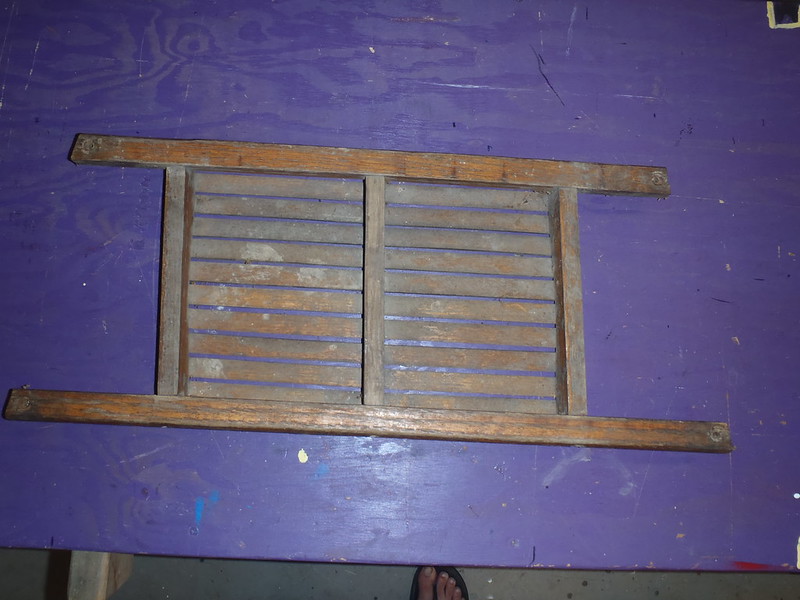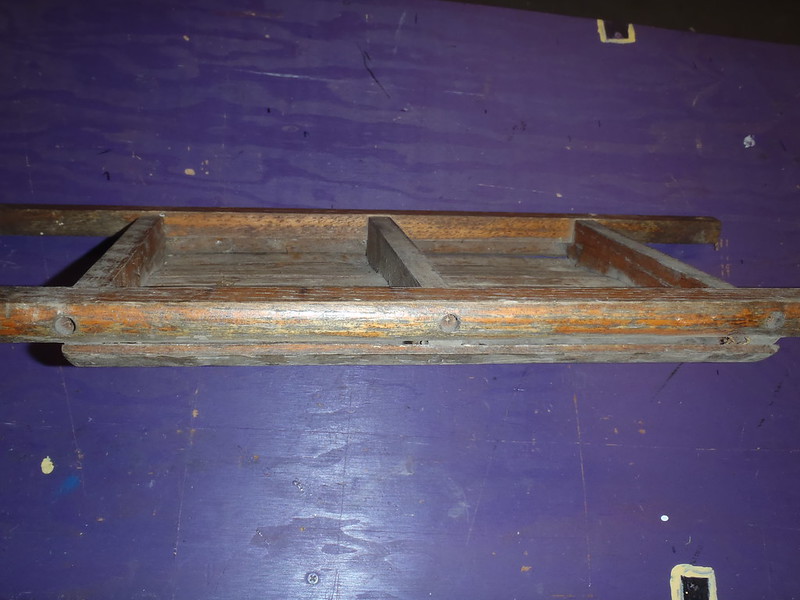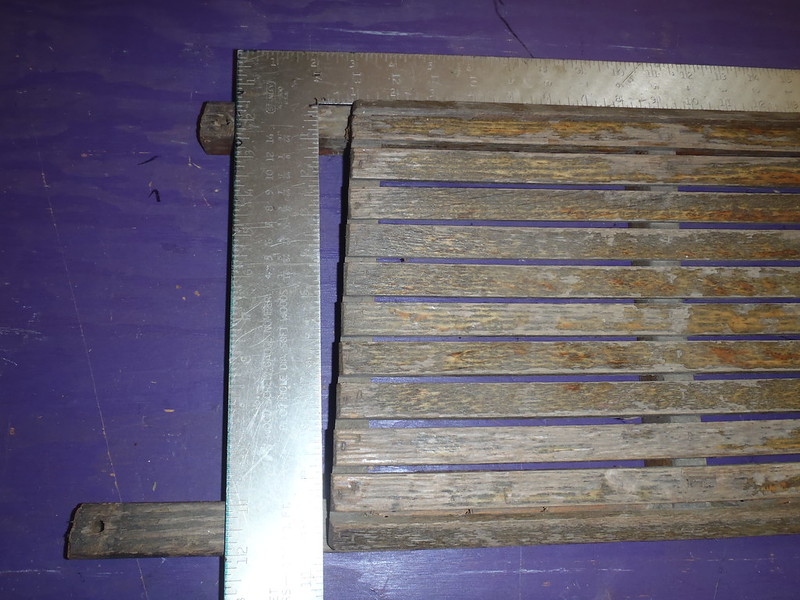G
Guest
Guest
I took this to a separate thread; those Shenandoah “Adirondack-chair” all-wood slat seats are comfortable sitting or kneeling and, aside from the three curvy base pieces, of simple basic construction. And they look cool in a kinda traditional way.
 P5120035 by Mike McCrea, on Flickr
P5120035 by Mike McCrea, on Flickr
Christine, I thought about replicating those back when I built seats, and a friend took one home to copy for seats in a 20’ WC freighter he was refurbishing. Those vintage Royalex Warsaw Rockets that Shenandoah trimmed out already weighed a ton, so another pound or two per seat didn’t matter much.
I pulled out the one I have left for a better look. We regunwaled and rebuilt a two of those old Shenadoahs, both passed along but still going beefy Royalex strong with friends today. The factory installed outfitting on those hulls was crude; 1” square inwales and outwales, not rounded off even a centimeter, attached with steel (not stainless) screws, all screws luckily countersunk through the outwale.
“Luckily” because getting those ancient corroded screws out was a chore, the rusted Phillips heads disintegrated on contact. I ended up carefully sawing through the outwale, in-between each of the corroded screw sections, and using the 6” piece of gunwale as a toggle to twist out the screws, snapping half of them in the process and then prying off the inwale with the remaining rusty screw shanks intact. T’was a nightmare just to get the gunwales off.
The Shenandoah seat I have left is a stern shortie. For funsies, on the shop scale, that seat weighs 2lbs 9oz. A similar sized webbed seat from Ed’s Canoe Parts weighs 1lb 11oz. Less than a pound difference, not as heavy as I thought. Seat construction looks like the same 1” square (oak?) stock as the gunwales, maybe less weighty than factory frash because it is now old decades in storage and aged dry as a bone.
Topside view
 P9220002 by Mike McCrea, on Flickr
P9220002 by Mike McCrea, on Flickr
Bottomside view
 P9220004 by Mike McCrea, on Flickr
P9220004 by Mike McCrea, on Flickr
Sideside views
 P9220005 by Mike McCrea, on Flickr
P9220005 by Mike McCrea, on Flickr
The slats are ¾” wide x ¼” thick. No idea what kind of wood, seems like Shenandoah used local oak for everydamnthing, so probably that again. The slats are held with brads, and probably some glue underneath.
The design does have the simplest of square notched “joints”, the frame is held together with 6 screws through the laterals, into the three curvy braces. A lot of the strength probably comes from the slats.
 P9220008 by Mike McCrea, on Flickr
P9220008 by Mike McCrea, on Flickr
Did I mention that Shenandoah’s outfitting was crude? I had never noticed how crude on the seats. There are three of those curvy pieces forming the butt base for the slats, including one in the center so the slats can’t sag under weight. Shenandoah installed all three as a bit of a parallelogram. Not even close to square, even the slats are cut a slight diagonal.
 P9220010 by Mike McCrea, on Flickr
P9220010 by Mike McCrea, on Flickr
 P9220011 by Mike McCrea, on Flickr
P9220011 by Mike McCrea, on Flickr
Slapdash work fellas. Friday afternoon boat? Did you have a few beers at lunch?
I kinda doubt that diagonal build was by design, and the seat frame isn’t torqued out of shape, it is rock freaking solid immovable. I clamped one arm in a vice and tried forcing it back to square, not happening. If nothing else that design makes for a dang sturdy seat.
I don’t imagine ever putting that ancient thing back in a canoe, and tried to disassemble it so I could trace a template of those only-tricky-bit curvy bottom supports. Disassembly was a nope; Shenandoah used the same beefy non-stainless screws, and all I did was strip the heads.
A template would be nice to have, and envelope postage easy to share if anyone is interested in building seats to that design. Without busting it apart I could still trace and cut some templates.
 P9230013 by Mike McCrea, on Flickr
P9230013 by Mike McCrea, on Flickr
I love saving templates for future use, or future design improvement. If anyone wants to DIY one of those seats I’d be happy to mail a curvy piece template.

That is actually a pretty slick idea.
Christine, I thought about replicating those back when I built seats, and a friend took one home to copy for seats in a 20’ WC freighter he was refurbishing. Those vintage Royalex Warsaw Rockets that Shenandoah trimmed out already weighed a ton, so another pound or two per seat didn’t matter much.
I pulled out the one I have left for a better look. We regunwaled and rebuilt a two of those old Shenadoahs, both passed along but still going beefy Royalex strong with friends today. The factory installed outfitting on those hulls was crude; 1” square inwales and outwales, not rounded off even a centimeter, attached with steel (not stainless) screws, all screws luckily countersunk through the outwale.
“Luckily” because getting those ancient corroded screws out was a chore, the rusted Phillips heads disintegrated on contact. I ended up carefully sawing through the outwale, in-between each of the corroded screw sections, and using the 6” piece of gunwale as a toggle to twist out the screws, snapping half of them in the process and then prying off the inwale with the remaining rusty screw shanks intact. T’was a nightmare just to get the gunwales off.
The Shenandoah seat I have left is a stern shortie. For funsies, on the shop scale, that seat weighs 2lbs 9oz. A similar sized webbed seat from Ed’s Canoe Parts weighs 1lb 11oz. Less than a pound difference, not as heavy as I thought. Seat construction looks like the same 1” square (oak?) stock as the gunwales, maybe less weighty than factory frash because it is now old decades in storage and aged dry as a bone.
Topside view

Bottomside view

Sideside views

The slats are ¾” wide x ¼” thick. No idea what kind of wood, seems like Shenandoah used local oak for everydamnthing, so probably that again. The slats are held with brads, and probably some glue underneath.
The design does have the simplest of square notched “joints”, the frame is held together with 6 screws through the laterals, into the three curvy braces. A lot of the strength probably comes from the slats.

Did I mention that Shenandoah’s outfitting was crude? I had never noticed how crude on the seats. There are three of those curvy pieces forming the butt base for the slats, including one in the center so the slats can’t sag under weight. Shenandoah installed all three as a bit of a parallelogram. Not even close to square, even the slats are cut a slight diagonal.


Slapdash work fellas. Friday afternoon boat? Did you have a few beers at lunch?
I kinda doubt that diagonal build was by design, and the seat frame isn’t torqued out of shape, it is rock freaking solid immovable. I clamped one arm in a vice and tried forcing it back to square, not happening. If nothing else that design makes for a dang sturdy seat.
I don’t imagine ever putting that ancient thing back in a canoe, and tried to disassemble it so I could trace a template of those only-tricky-bit curvy bottom supports. Disassembly was a nope; Shenandoah used the same beefy non-stainless screws, and all I did was strip the heads.
A template would be nice to have, and envelope postage easy to share if anyone is interested in building seats to that design. Without busting it apart I could still trace and cut some templates.

I love saving templates for future use, or future design improvement. If anyone wants to DIY one of those seats I’d be happy to mail a curvy piece template.
